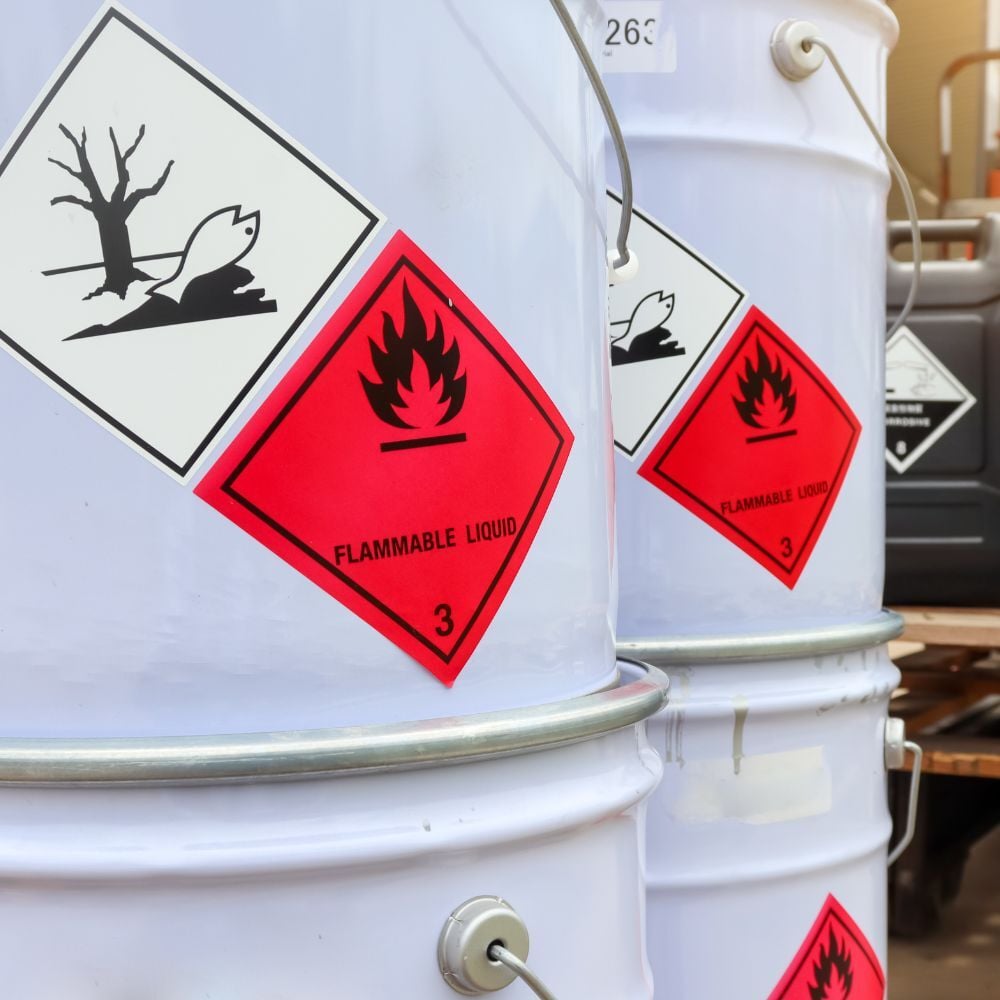
What Chemicals Are In Hazard Class 3?
Hazard Class 3 includes flammable liquids that have a flash point at or below 140°F (60°C).
You may recognize some of these common chemicals - gasoline, diesel fuel, ethanol, acetone and various industrial solvents. Yet all too often, hazardous chemicals get lumped into one category. In reality, Hazard Class 3 chemicals have distinct properties and risks that set them apart from other hazardous materials.
While they all share a high flammability factor, their flash points, volatility and chemical compositions vary, affecting how they must be stored, transported and disposed of safely. Understanding these differences is crucial for your business to implement the correct safety measures and regulatory compliance protocols.
What is Hazard Class 3?
Hazard Class 3 is a designation under the U.S. Department of Transportation (DOT) and other international regulatory agencies for flammable liquids. These liquids are defined by their ability to ignite at relatively low temperatures.
The classification of a flammable liquid depends on its flash point, which is the lowest temperature at which its vapors can ignite when exposed to an ignition source.
This class is further divided into three packing groups based on the degree of danger.
Packing Group I represents high danger, with a flash point below 73°F and a boiling point below 95°F.
Packing Group II includes moderately dangerous liquids, with a flash point below 73°F but a boiling point above 95°F.
Packing Group III contains flammable liquids with a lower risk, having a flash point between 73°F and 140°F.
What Chemicals Are in Hazard Class 3?
Many chemicals fall under Hazard Class 3, several of which are commonly used in industrial, commercial and consumer applications.
- Gasoline is perhaps the most well-known, serving as a primary fuel for internal combustion engines.
- Diesel fuel, while having a slightly higher flash point than gasoline, still qualifies as a flammable liquid under specific conditions.
- Ethanol and other alcohol-based solutions are also part of this classification. They are widely used in industrial processes, pharmaceuticals and even consumer products like hand sanitizers.
- Acetone, a solvent found in nail polish removers and paint thinners, is highly volatile and poses significant fire risks.
- Toluene and xylene, often found in adhesives, paints and coatings, are known for their strong odors and flammability.
- Benzene, a component of crude oil and gasoline, is both highly flammable and a known carcinogen, making it particularly hazardous.
- Methanol, commonly used in antifreeze and fuel additives, is another highly flammable and toxic liquid.
- Turpentine, which is derived from tree resin and used in paints and varnishes, presents similar risks.
All of these chemicals require careful handling and strict safety measures to prevent accidents.
How Should Hazard Class 3 Chemicals Be Stored?
Proper storage of Hazard Class 3 chemicals is critical for preventing fires and ensuring workplace safety. These chemicals should always be kept in approved containers that meet OSHA and NFPA standards, including safety cans or specially designed drums.
Storage areas must be well-ventilated to prevent vapor buildup, which can create a significant fire hazard. Temperature control is also critical since exposure to heat sources, direct sunlight or electrical equipment can lead to ignition.

If your facility stores large quantities of flammable liquids, you must have fire suppression systems in place, including automatic sprinklers and fire extinguishers rated for flammable substances.
Another key precaution is keeping flammable liquids segregated from incompatible chemicals like oxidizers and corrosives, which could cause dangerous reactions. Clearly marking storage areas with appropriate hazard signage and ensuring that safety data sheets (SDS) are readily available further enhances workplace safety.
By following these best practices, businesses can minimize the risks associated with storing flammable liquids.
How Should Hazard Class 3 Chemicals Be Disposed Of?
While it may be tempting to pour substances down drains and into sewer systems, disposing of flammable liquids improperly can have severe consequences, including environmental contamination and regulatory penalties.
Instead, waste flammable liquids must be collected in designated hazardous waste containers that meet DOT and EPA requirements and safely transported to disposal sites.
Some flammable liquids, such as solvents and fuels, can be reclaimed and purified for reuse, reducing overall waste and environmental impact. When recycling is not an option, incineration at a certified hazardous waste facility may be used to neutralize these chemicals safely.
Many municipalities and industrial facilities also have hazardous waste collection programs, making it easier for businesses to dispose of flammable liquids responsibly. Ensuring proper disposal protects both the environment and public safety.
Why Is a Certified Hazardous Waste Disposal Company Important?
A certified hazardous waste disposal company plays a vital role in ensuring your business is in compliance with safety and environmental regulations. A top disposal company will adhere to strict guidelines set by the EPA, OSHA and DOT to help your business avoid fines and legal consequences.
Proper disposal of hazardous waste isn’t simply about transporting waste from point A to point B. It’s also about ensuring that hazardous materials are handled and disposed of safely, reducing the risk of spills, fires and contamination. When looking for a waste management partner, look for services that can help you manage all aspects of your waste, from site cleanup and remediation to sampling and analysis services.
By following best practices and working with certified hazardous waste disposal companies, your business can ensure the safe and responsible management of these hazardous materials.
Hazard Class 3 includes flammable liquids that have a flash point at or below 140°F (60°C).
Subscribe to our Newsletter!
Sign up to receive environmental news and updates!

